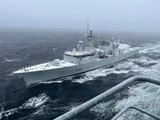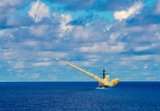US Navy to conduct an experimentation campaign with emerging tech in 2026 and 2027
The Technology Operational Experimentation Events will inform future requirements as the US Navy looks for innovative solutions across three key operational domains.
The US Naval Air Systems Command’s (NAVAIR) Tactical Airlift Program Office (PMA-207) Commercial Modifications and Range Support team has accepted delivery of a new Gulfstream G550-derivative aircraft.
The modified Gulfstream G550 has been adapted to house specialised telemetry equipment, unique to the navy’s application. The G550 will serve as the replacement for an aging P-3 range support aircraft operated out of Naval Air Warfare Center Weapons Division in Point Mugu, California.
The aircraft’s airborne early warning structural modifications will allow the installation of a telemetry system and additional equipment to support future missions.
Raytheon, the aircraft’s Phase II integrator, will now receive the aircraft and develop, procure and integrate systems that will give the aircraft a multi-role capability in telemetry data collection, range safety and surveillance and communications relay.
The aircraft is expected to be delivered for initial operating capability by August 2021.

The Technology Operational Experimentation Events will inform future requirements as the US Navy looks for innovative solutions across three key operational domains.

Although the CDC project is still in its early stages, the Canadian Department of National Defence already has some requirements for the future platforms.

The Naval Supply Systems Command is seeking authorised resellers of JaiaBot uncrewed underwater vehicles and multivehicle pods. The platforms will support undergraduate education at the US Naval Academy.

As part of its effort to better prepare its capabilities for operations in contested and congested scenarios, NATO evaluated a Lithuanian ship-to-ship terminal designed to not be susceptible to enemy interference.

The US Navy plans to improve Harpoon’s anti-ship and land attack capabilities by equipping the missiles with sensors and technologies required for succeeding in future battlespace.

The Canadian government remains tight-lipped on the timeline and funding required for the next steps of its Canadian Submarine Patrol Project, which should offer improved capabilities for the country’s navy.